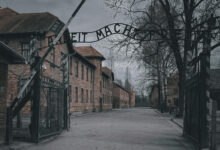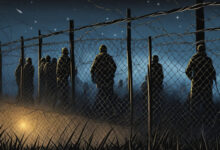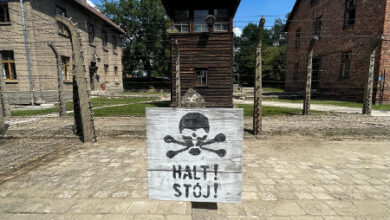Small group tour to Auschwitz
Small Group Auschwitz Tours: A Closer, More Engaging Historical Insight
Visiting Auschwitz-Birkenau can be an overwhelming experience. A small group tour to Auschwitz offers a more intimate and personal way to explore this haunting site. You’ll gain deeper insights into the history of the Nazi concentration camp and the Holocaust with fewer distractions.

Auschwitz small group tours typically limit participants to 15 people or less. This allows you to hear your guide clearly and ask questions more easily. You’ll have a better chance to reflect on what you’re seeing without being rushed or crowded.
These tours usually cover both Auschwitz I and Auschwitz II-Birkenau. You’ll see key areas like the gas chambers, crematoria, and prisoner barracks.
Your guide will share stories of those who suffered here during World War II. It’s a powerful way to learn about this dark chapter in history and honour the victims.
Preparing for Small group tour to Auschwitz

Planning ahead is crucial for a meaningful visit to Auschwitz. Proper preparation ensures a smooth and respectful experience at this solemn site.
Booking Your Small Group Tour
Book your small group tour well in advance. Tours often fill up quickly, especially during peak seasons. Choose a reputable company that offers hotel pickup and air-conditioned transport. Look for tours with free cancellation options in case your plans change.
Many companies provide guided day trips from Krakow. These usually include round-trip transportation and entry to both Auschwitz I and Auschwitz II-Birkenau camps. Small groups typically have 15 or fewer people, allowing for a more intimate experience.
Meeting Point and Transportation
If hotel pickup is included, confirm the exact time and location with your tour operator. For tours without pickup, you’ll need to make your way to a central meeting point in Krakow.
The journey to Auschwitz takes about 1.5 hours each way. Most tours use comfortable, air-conditioned minivans or coaches. During the ride, your guide may provide background information or show documentaries to prepare you for the visit.
What to Bring and Dress Code
Pack essentials for a full day out:
- Valid ID (passport or national ID card)
- Comfortable walking shoes
- Weather-appropriate clothing
- Water and snacks (or a packed lunch)
- Camera (if permitted by your tour)
Dress respectfully, as Auschwitz is a memorial site. Avoid shorts, sleeveless tops, or clothing with offensive slogans. In colder months, bring warm layers as much of the tour is outdoors.
Remember to charge your mobile phone and bring a portable charger if needed. Some tours provide audio headsets, but you may want to bring your own earphones for comfort.
Small group tour to Auschwitz Experience

Your small group tour to Auschwitz provides a sobering and educational experience. The guided journey takes you through the key areas of the Auschwitz-Birkenau complex, offering insights into the atrocities committed during the Nazi Holocaust.
Guided Tour Itinerary
Your tour begins at Auschwitz I, where you’ll pass under the infamous “Arbeit Macht Frei” gate. You’ll visit various buildings housing exhibits on camp life and the mass extermination that took place here. Your guide will lead you through prisoner barracks, gas chambers, and crematoriums.

Next, you’ll travel to Auschwitz II-Birkenau, about 3 km away. Here, you’ll see the iconic guard tower and railway tracks where prisoners arrived. You’ll explore the vast camp grounds, including the ruins of gas chambers and memorial sites.
The tour typically lasts 3.5 hours, allowing time to see both camps thoroughly.
Memorial and Museum
At Auschwitz I, you’ll find the main museum exhibits. These displays feature personal belongings of victims, photographs, and documents that bring the camp’s history to life. You’ll see rooms filled with shoes, suitcases, and other items that belonged to those who perished.

The Birkenau site serves primarily as a memorial. Here, you’ll find the International Monument to the Victims of Fascism. This powerful tribute stands as a reminder of the lives lost and the importance of remembering this dark chapter in history.
Understanding the Site’s History
Your guided tour provides crucial context to help you grasp the scale and significance of what occurred at Auschwitz-Birkenau. You’ll learn about the camp’s role in the Nazi’s “Final Solution” and the systematic murder of over a million people, mostly Jews.
Your guide will explain how the camp evolved from a concentration camp to an extermination centre.
You’ll hear stories of individual prisoners and learn about resistance efforts within the camp. This historical background helps you better understand the exhibits and sites you’re seeing.
Accessibility and Visitor Services
Auschwitz-Birkenau offers services to make visits accessible for people with different needs. The site aims to provide a respectful experience for all guests.

Facilities and Accessibility Features
The main areas of Auschwitz I and Birkenau are wheelchair accessible. You’ll find ramps and lifts at key points. Wheelchairs are available to borrow free of charge, but in limited numbers. It’s best to book these in advance.
Accessible toilets are located near the main entrance and visitor centre. Guide dogs are welcome on site. For visitors with hearing impairments, some exhibits have subtitles or transcripts.
The visitor centre has a cloakroom, café, and bookshop. Free WiFi is available in certain areas. Staff at information desks can assist with queries and provide maps.
Guidance for Visitors with Mobility Impairments
If you have mobility issues, you can request a tailored tour. These cover key areas that are easier to access. You may use your own wheelchair or mobility scooter.
It’s important to note that some historical buildings have narrow doorways or steps. The grounds can be uneven in places. You might want to bring a companion to help.
For online tours, you can join from the comfort of your home. These last about two hours and cover both camps. You’ll see live narration and multimedia materials.
Exploring Auschwitz-Birkenau

A visit to Auschwitz-Birkenau is a profound experience that offers insight into one of history’s darkest chapters. You’ll encounter powerful reminders of the Holocaust as you tour the camps and learn about the lives lost.
Auschwitz I and II-Birkenau
Auschwitz I, the main camp, houses exhibits in former prisoner barracks. You’ll see personal items, photographs, and documents that tell victims’ stories. The infamous “Arbeit Macht Frei” gate marks the entrance.

Auschwitz II-Birkenau, built later, was the largest extermination camp. Its vast size is striking. You’ll view the ruins of gas chambers and crematoriums destroyed by retreating Nazis. The railway tracks leading into the camp are a chilling sight.
Both sites have watchtowers and barbed wire fences that show the camps’ prison-like nature. Original barracks at Birkenau give you a sense of prisoners’ living conditions.
Key Sites Within the Camps
At Auschwitz I, you’ll see the “Black Wall” execution site and Block 11, known as the “Death Block”. The gas chamber and crematorium here are preserved.

Birkenau’s “Gate of Death” railway entrance is iconic. The selection point on the platform decided prisoners’ fates. You can enter reconstructed barracks to see cramped living spaces.

The ruins of gas chambers and crematoriums at Birkenau are sobering. A memorial stands near their remains. The “Sauna” building, where prisoners were processed, now houses exhibits.
Preserving the Memory
The Auschwitz-Birkenau State Museum works to preserve the camps’ remains. You’ll find many original structures and artefacts on display.
Guided tours provide context and share survivors’ accounts. The museum’s archives hold records and testimonies that aid research and education.
Memorial plaques in many languages honour victims. The International Monument at Birkenau is a focal point for remembrance. Special exhibits explore different aspects of camp history.
By visiting, you play a role in ensuring these events are not forgotten. The site serves as a powerful warning about the dangers of hate and intolerance.
Further Explorations

After visiting Auschwitz, you might want to learn more about Poland’s history and culture. Two nearby sites offer unique experiences that complement your tour.
Wieliczka Salt Mine
You can explore the Wieliczka Salt Mine, a UNESCO World Heritage site. This underground marvel is just 14 km from Krakow. It features chambers carved out of salt and stunning sculptures.
The mine has nine levels and reaches a depth of 327 metres. You’ll see underground lakes, chapels, and statues all made of salt. The highlight is the Chapel of St. Kinga, a massive chamber with chandeliers and carvings.


Guided tours last about 2-3 hours. They cover 3.5 km of tunnels and chambers. You’ll learn about the mine’s 700-year history and the lives of the miners who worked there.
Krakow’s Historical Significance

Krakow itself is rich in history related to World War II and the Holocaust. You can visit Oskar Schindler’s Enamel Factory, now a museum. It tells the story of Krakow under Nazi occupation.
The Jewish Quarter, Kazimierz, is worth exploring. Once home to a thriving Jewish community, it was devastated during the war. Today, it’s a vibrant area with synagogues, museums, and Jewish restaurants.
You can also see remnants of the Krakow Ghetto where Jews were forced to live. The Ghetto Heroes Square memorial honours those who suffered and died there.
Frequently Asked Questions

Visiting Auschwitz requires careful planning and consideration. Here are answers to common questions about small group tours to this important historical site.
What are the recommended options for joining a guided tour of Auschwitz with hotel pickup included?
Many tour companies offer small group excursions to Auschwitz with hotel pickup. These typically include transport from Krakow, entry fees, and an English-speaking guide. Some popular options are GetYourGuide, Viator, and local Polish tour operators.
Booking in advance is essential, especially during peak tourist seasons. Tours usually last 6-7 hours, including travel time.
Are there any respectful attire guidelines visitors should follow when touring Auschwitz?
Modest, respectful clothing is expected when visiting Auschwitz. Avoid wearing shorts, sleeveless shirts, or clothing with offensive images or slogans.
Comfortable, closed-toe shoes are recommended as you’ll be walking on uneven ground. Bring a jacket or layers, as the weather can be unpredictable.
How much time should visitors allocate for a thorough visit to Auschwitz?
A thorough visit to Auschwitz-Birkenau typically takes 3.5 to 4 hours. This allows time to explore both Auschwitz I and Auschwitz II-Birkenau camps.
If you’re on a guided tour, factor in additional time for transportation to and from your accommodation. A full-day trip from Krakow usually lasts 6-8 hours.
Which accommodation options are conveniently located for visitors planning to tour Auschwitz?
Staying in Krakow is the most popular choice for visitors to Auschwitz. The city offers a wide range of hotels and is about 70 km from the memorial site.
For those who prefer to stay closer, the town of Oświęcim (where Auschwitz is located) has a few hotels and guesthouses. This can be convenient for early morning visits.
Are visitors permitted to explore Auschwitz without the accompaniment of a guide?
Individual visitors can explore Auschwitz without a guide during certain hours, but it’s not recommended. The site is vast and complex, and a guide provides crucial context.
Start Planning Your Krakow Trip Now!
- Unsure where to stay in Krakow? Discover top-rated Old Town and Kazimierz hotels with Booking.com.
- Book your airport transfer now and enjoy a hassle-free ride directly to your hotel. Driver will meet you at John Paul II International Airport Kraków–Balice.
- Take a Tour of Auschwitz. Arrange a visit to the Auschwitz-Birkenau Memorial and Museum to pay tribute and learn about this significant historical site.
⚠️ SUMMER BOOKING ALERT: Auschwitz tours are in high demand during the busy summer season. Secure your visit now to guarantee your preferred date and time slot. Last-minute availability cannot be guaranteed during this peak season. Due to increased visitor numbers in summer, it’s strongly recommended to book your tickets and tour to Auschwitz well in advance to secure your preferred dates and times! 🔖
- Explore the Fascinating Wieliczka Salt Mine! Book your guided tour today. These tours are very popular, so book early to avoid disappointment and ensure your spot.
- Looking for ideas? Check out our KrakowTOP.org recommended itineraries, including the famous Christmas Market, holiday events, and must-see Krakow attractions like Wawel Castle, Oskar Schindler’s Factory and St. Mary’s Basilica.
During peak hours (10 am to 4 pm), entry is only allowed with an official guide. It’s best to book a guided tour for the most informative experience.
Do small group tours to Auschwitz provide any educational materials or resources?
Most small group tours to Auschwitz provide educational resources. These often include informational booklets, maps, and sometimes audio guides.
Some tour operators offer pre-trip materials to help you prepare for the visit. On-site, your guide will share in-depth historical information and personal stories throughout the tour.










